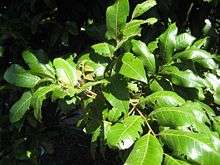Alectryon excelsus
| Tītoki | |
|---|---|
| | |
| Scientific classification | |
| Kingdom: | Plantae |
| (unranked): | Angiosperms |
| (unranked): | Eudicots |
| (unranked): | Rosids |
| Order: | Sapindales |
| Family: | Sapindaceae |
| Genus: | Alectryon |
| Species: | A. excelsus |
| Binomial name | |
| Alectryon excelsus Gaertn. | |
Alectryon excelsus, commonly known as tītoki, is a shiny-leaved tree native to New Zealand, where it occurs in coastal and lowland forests. It is found throughout most of the North Island and from Banks Peninsula to central Westland in the South Island.
In common with most New Zealand native trees, the Māori name is now preferred for English use. It was formerly known as New Zealand oak.
Description
Alectryon excelsus is a canopy tree growing to 9 m (30 ft) in height. It has a twisting trunk with smooth dark bark, spreading branches and pinnate leaves.[1]
Alectryon excelsus produces small purple flowers in spring and the seeds take up to a year to mature. The colourful seed is initially contained in a hairy woody capsule which splits revealing bright red and black unpalatable fruit (the black portion being the seed). The fruit is a favourite food of the New Zealand wood pigeon.

References
- ↑ Parsons, Mick. "Alectryon excelsus (Titoki)" (PDF). Wellington City Council. Retrieved 15 September 2013.
- Metcalf, Laurie, 2002. A Photographic Guide to Trees of New Zealand. Auckland: New Holland.
- Salmon, J.T., 1986. The Native Trees of New Zealand. Wellington: Heinemann Reed.
External links
- New Zealand Plant Conservation Network: Alectryon excelsus excelsus. Accessed 2010-10-04.
- New Zealand Plant Conservation Network: Alectryon excelsus grandis. Accessed 2010-10-04.
| Wikimedia Commons has media related to Tītoki. |